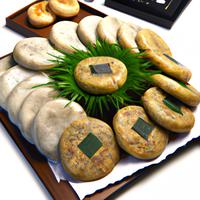
1 serving (100 grams) contains 230 calories, 4.0 grams of protein, 0.5 grams of fat, and 50.0 grams of carbohydrates.

Log this food in SnapCalorie

Nutrition Information
Calories |
575 | ||
|---|---|---|---|
% Daily Value* |
|||
| Total Fat | 1.2 g | 1% | |
| Saturated Fat | 0.2 g | 1% | |
| Polyunsaturated Fat | 0 g | ||
| Cholesterol | 0 mg | 0% | |
| Sodium | 25 mg | 1% | |
| Total Carbohydrates | 125 g | 45% | |
| Dietary Fiber | 2.5 g | 8% | |
| Sugars | 2.5 g | ||
| protein | 10 g | 20% | |
| Vitamin D | 0 mcg | 0% | |
| Calcium | 25 mg | 1% | |
| Iron | 1.2 mg | 6% | |
| Potassium | 50 mg | 1% | |
* Percent Daily Values are based on a 2,000 calorie diet. Your daily values may be higher or lower depending on your calorie needs.
Food Attributes
Source of Calories
About Korean ricr cakes
Korean rice cakes, known as "tteok," are a staple in Korean cuisine, often enjoyed during celebrations and traditional events. Made primarily from glutinous rice flour, they come in a variety of shapes, textures, and flavors, such as chewy, dense, or soft. Common ingredients include rice, water, sugar, nuts, fruits, and natural food coloring, while savory versions often include sesame oil, soy sauce, or chili paste. As a low-fat and gluten-free food, tteok provides a source of carbohydrates for energy, though its nutritional profile can vary based on preparation. Some versions, like the sweet fillings or fried styles, can be higher in sugar or calories. Rich in cultural heritage, tteok remains versatile, offering both wholesome options like steamed varieties and indulgent treats. Moderation is key if you're watching your intake, especially for sweeter or seasoned varieties.



